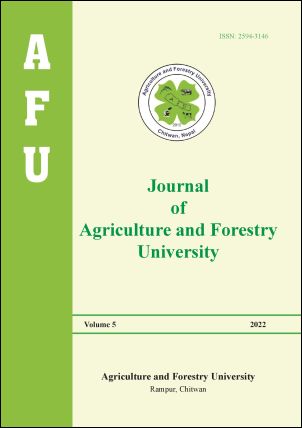Husbandry practice, health, productive and reproductive status of lulu cattle in Mustang, Nepal
DOI:
https://doi.org/10.3126/jafu.v5i1.48464Keywords:
Indigenous cattel, endoparasitic infection, body condition score, calving seasonAbstract
Lulu is the only indigenous cattle of taurine (Bos taurus) breed that is reared in northern part of central to western Nepal. There have been no recent studies on husbandry practice, health status, productive and reproductive performance of Lulu cattle in Nepal. Therefore, this study was conducted to know the husbandry practice, health, productive and reproductive status of Lulu cattle in Mustang district. Household survey was conducted in Lulu cattle rearing households (n=183) in Mustang; fecal sample of Lulu cow was collected from each household and examined for endoparasitic infection. Body condition score (BCS), hair coat, anemic and milk production status were recorded only from lactating cows (n=242). All of the respondents kept their cows in loose housing system. Among them, 90.2% grazed their cattle, 21.3% provided some cultivated pastures, 3.3% supplemented commercial feed and none of the farmers fed mineral supplementation to their cattle. All the milk produced was used only for home consumption. Only 22% of respondents dewormed their cattle regularly and 29% never dewormed; only 12% vaccinated against foot and mouth disease (FMD) every year and 25% never vaccinated. Cattle of 79.8% households had endoparasitic infection. Among 242 lactating cows, 13.2% cows had poor BCS (<2.75), 95.5% had rough hair coat and 20.4% had anemic (pale) eye mucous membrane. Total 8.3% cows had the history of abortion. Mean (±SD) peak milk yield and lactation length were 2.01±0.30 liter/day and 9.84±0.86 months, respectively. Most of the cows calved in summer (72%) followed by autumn (12%), spring (11%) and winter (5%). Mean (±SD) age of first calving, calving to conception interval, inter-calving interval, dry period and the number of services per conception were 36.0±0.48 months, 3.99±0.68 months, 12.97±1.34 months, 2.71±0.45 months, and 1.47±0.77, respectively. In conclusion, Lulu cattle has the potentiality to increase its productive and reproductive performance through improved health and husbandry practices.
Downloads
Downloads
Published
How to Cite
Issue
Section
License
Copyright (c) 2022 Agriculture and Forestry University (AFU), Rampur, Chitwan, Nepal

This work is licensed under a Creative Commons Attribution-NonCommercial 4.0 International License.
This license allows reusers to distribute, remix, adapt, and build upon the material in any medium or format for noncommercial purposes only, and only so long as attribution is given to the creator.




